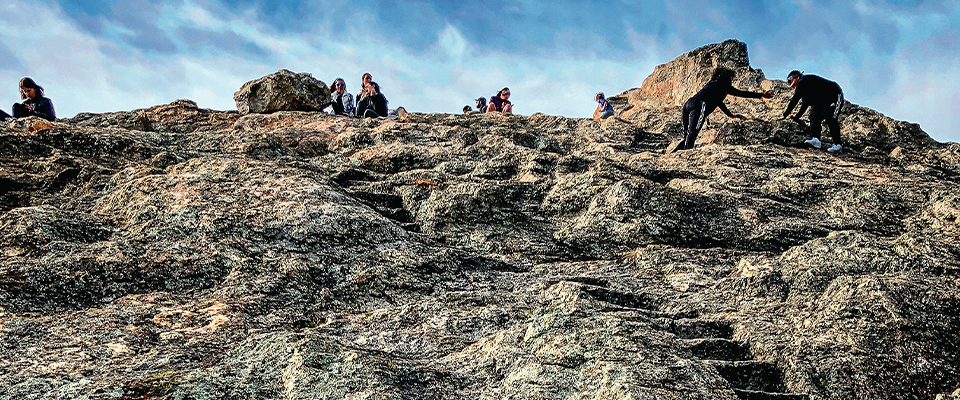Lately, I’ve been spending time at Founders’ Rock trying and mostly failing to get a grasp on reality.
Founders’ Rock is an outcropping at the northeast corner of the UC Berkeley campus, where Gayley Road and Hearst Avenue meet, a lonely spot shaded by toyon, oak, and eucalyptus. The rock itself—lichen-encrusted and moss-fringed—is an unassuming jumble.
Aside from the squirrels and transients—and lately, me—it receives few visitors. Most students and passers-by never pay it any mind. For them, it may as well not exist.

Yet for all its relative obscurity, Founders’ Rock is, as the name suggests, at the very heart of the University’s story, for it was here that the both the campus and the city that grew up around it came by their name, 150 years ago.
It was in the spring of 1860, just days after the first Pony Express rider made it to California, that the trustees of the College of California in Oakland first met to survey the land they had secured upon which to establish a new university. The real estate was an open swath of oak-studded savannah that sloped gently downward toward the bay and was reliably watered by a stream that spilled from the hills. The trustees, four of whom were reverends, hitched their teams by that stream, and gathered at the rock, then a prominent landmark in the surrounding landscape, to consecrate the site as a “seat of Christian learning.”
They would meet again at the “great rock” six years later and from it, they looked out to the Golden Gate, where ships weighed anchor and set sail. Observing the scene, one of the men was moved to recite a snatch of verse.
Westward the course of empire takes its way;
the first four acts already passed.
A fifth shall close the Drama with the day;
Time’s noblest offspring is the last.
It was the final stanza in a poem by one George Berkeley, Bishop of Cloyne. An Irishman who would have pronounced his surname to rhyme with “darkly,” Berkeley had himself once dreamed of creating a university in the New World—specifically Bermuda—where he hoped to educate both settlers and Native Americans. Whether it was due to that fact or simply in appreciation of his enthusiastic expression of manifest destiny, Berkeley struck the men as a capital name for the new institution.
As for the rock, it remained for many decades an important spot for campus observances, and its north-facing flank was long ago graced with a marble tablet bearing the date of the trustees’ original rendezvous: April 16, 1860. By then, the good bishop had been dead more than a hundred years, his own course having never run farther west than colonial Rhode Island, where he waited three years for the funds he needed to start his college in the Americas. As is so often the case in academics, the money never materialized, and Berkeley returned home to the British Isles. Today, he is best remembered not as an educator or poet but as the philosopher whose famous dictum esse est percipi—to be is to be perceived—is a cornerstone of idealism.
In Berkeley’s conception, it isn’t just the sound of the falling tree that requires a perceiver in order to be realized; without a perceiver, the tree itself does not exist. Nothing does.
We now tend to think of idealism as a naïve devotion to high-minded principles, but philosophical idealism is something different—an assertion that reality is fundamentally mind-dependent.
The well-known thought experiment about the tree that falls in a forest when no one is around to hear it is often erroneously, if understandably, credited to Berkeley. The question is, does the tree make a sound? The answer is no. When the tree falls, it creates a disturbance in the air that spreads outward in all directions, but it only registers as a sound if it chances upon an ear capable of hearing it. The sound’s esse, in other words, is indeed its percipi.
But while the example is certainly in keeping with Berkeley’s basic philosophy, his own notion of reality cut deeper still.
In his conception, it isn’t just the sound of the falling tree that requires a perceiver in order to be realized; without a perceiver, the tree itself does not exist. Nothing does. As he wrote in his 1710 treatise, Of the Principles of Human Knowledge: “All the choir of heaven and the furniture of the earth—in a word, all those bodies which compose the frame of the world—have not subsistence without a mind.”
Though Berkeley’s school of thought is now generally referred to as idealism, he himself called it “immaterialism.” Whatever –ism you prefer, the astonishing fact remains: The greatest public university in the world is named for a man who denied the objective reality of matter.
Founders’ Rock is part of the furniture of the earth—a piece brought up from the basement, apparently. According to the late Berkeley geologist Garniss Curtis, it began as intrusive rock that cooled and crystallized deep underground before being carried to its present site, considerably altered by chemical processes, and thrust to the surface by the forces of the Hayward Fault.
That fault is, of course, an underlying physical reality of life on the Cal campus, and its presence—largely unseen and only infrequently felt—explains much about the local topography. It was the action of the fault that created the backdrop of the Berkeley Hills, which rise abruptly to catch the Pacific sea-fogs and send them back to the bay as runoff. Strawberry Creek, the drainage that cuts through campus, crosses the fault zone in a culvert buried beneath Memorial Stadium. In the short space from where it plunges beneath the bleachers to where it emerges behind the Women’s Faculty Club, the creek is offset by more than a thousand feet, its course shunted sideways by the inexorable, slow-motion creep of the plates.
In fact, several “beheaded” stream channels mark the terrain. These are creek beds that have long since parted company with the headwaters. Hearst Avenue is likely one such ancient channel, which means that at some point, eons before it became the seat of Christian learning, Founders’ Rock might have made a fine fishing spot. And eons hence, as it migrates northward, a few scant millimeters per year, it will eventually sidle up to San Pablo Bay. This, in any case, is the rather surreal picture the geologists paint regarding the ground beneath our feet. It moves.

Of course, the motion of the plates—like all motion—is relative, something that George Berkeley posited almost two centuries before Ernst Mach or Albert Einstein. In his 1721 essay, “De Motu,” Berkeley countered his contemporary Isaac Newton’s idea that space, time, and motion were absolutes. To the contrary, he insisted, no physical body could move or rotate except in relation to other bodies.
It may seem strange that a man who denied the existence of material objects would bother discoursing upon their behavior, but Berkeley certainly did. He was an empiricist; that is, he believed that all human knowledge derived from our senses. And as Cal philosophy professor Kristen Primus explained to me, “Like all empiricists, he cared about ensuring that we can know things, that reality is there to be known securely by us.” He wanted to avoid skepticism, the idea that nothing is ultimately knowable. Yet baked into empiricism was a troubling question: How can we know anything about the world outside us?
Other thinkers had struggled with the same question. The materialist Hobbes argued that nothing existed but matter, while Descartes took the dualist position, that ideas and matter were simply two discrete things. Both conceptions, Primus said, require “that you come up with this material object that’s independent of all thought, and you can’t really coherently think of that.” Berkeley solved the problem by taking empiricism to an extreme. If the only access we have to the world of things “out there” is as the collection of ideas that form in our minds about them, then Berkeley decided that mind, not matter, must be the fundamental reality. As the writer Will Durant put it in The Story of Philosophy, “It was a brilliant idea—to refute materialism by the simple expedient of showing that we know of no such thing as matter; in all Europe,” he added, “only a Gaelic imagination could have conceived this metaphysical magic.”
Magic trick or not, the result is at once coherent and deeply unsettling, for as Cal philosopher John Campbell put it, all we’re left with “are ways of organizing or thinking about the internal furniture of the mind.” Nothing independent of our minds is there. “That’s basic idealism.” Laughing, he added, “If you’re not startled, you haven’t understood very well.”
The great English writer Samuel Johnson was both startled and defiant. As his biographer James Boswell related the story:
After we came out of church we stood talking for some time together of Bishop Berkeley’s ingenious sophistry to prove the non-existence of matter, and that every thing in the universe is merely ideal. I observed, that though we are satisfied his doctrine is not true, it is impossible to refute it. I shall never forget the alacrity with which Johnson answered, striking his foot with mighty force against a large stone, till he rebounded from it, “I refute it thus.”
I confess I’ve kicked Founders’ Rock a few times while working on this story. I can attest both to its solidity and to the fact that it was always there, waiting for me when I showed up. Or did it merely render before my eyes like the virtual worlds in computer games? If so, how then to explain the passing traffic? How to explain the existence of other people and the fact of our shared reality?
“The universe is made of events … interactions of quantum fields, and the things we choose to call them, like ‘matter’ or ‘objects,’ are really just the result of the way the world is perceived.”
Berkeley had an answer; namely God, the Divine Mind that perceives everything. “It’s not just that God perceives the rock,” explained Kenneth Winkler, a philosopher at Yale who has written extensively on Berkeley. “He’s actively responsible for the ideas we have when we interact with the rock.”
“Berkeley doesn’t deny a reality behind our experience,” he continued. But “it’s a spiritual reality, not the reality of a hard, indifferent, physical world.”
So, where, I wondered, did that leave the geologists, who delved into the Earth to determine the chemical compositions of minerals and arrive at their theories of plate tectonics and continental drift? Were they just elucidating the illusory? Not at all, insisted Winkler. Berkeley, he told me, thought of scientists as the “grammarians of the language of nature.” In studying natural phenomena, they were effectively reading the words of the Creator. God, in other words, is in the details.
This mingling of theology and science may strike us as odd today. As John Campbell observed, science now has a momentum of its own, but it was long seen as a fundamentally theistic enterprise. “You’re just finding out what God was up to.”
That idea still had currency when the University was founded. Winkler reminded me that, in fact, Berkeley’s founding geologist, the famous naturalist Joseph LeConte, was an idealist who felt that God was immanent in nature, residing in its facets and features. As a scientist, he was persuaded by Darwin’s theory of evolution but felt it could be reconciled to, and even complement, the Holy Bible; Genesis, LeConte felt, should be read as allegory.
“The phenomena of Nature are naught else than the objectified modes of divine thought,” he wrote.
LeConte in turn influenced his student, California native Josiah Royce, who would become America’s greatest idealist philosopher. Royce, who left Berkeley for Cambridge in 1882, once said, “I teach at Harvard that the world and the heavens and the stars are all real, but not so damned real, you see.”
A large, gilt-framed portrait of George Berkeley now hangs on the west wall of Heyns Reading Room in Doe Library. In it, the university’s namesake is portrayed holding a book, looking thoughtful and benevolent, a smile just beginning to form across his lips. Above his head, the names of some of the West’s greatest minds, from Plato to Darwin, are carved in the frieze that adorns the ceiling.
Berkeley was himself one of the great intellects, of course, and he kept company with other literary giants of his era, including his friend Jonathan Swift, author of Gulliver’s Travels, and the great satirical poet, Alexander Pope, who ascribed to Berkeley “ev’ry virtue under heaven.”
“Berkeley’s model is, ‘OK, give me this, the generation of an idea by a mind, … and I will explain everything else to you.’”
Despite those virtues, Berkeley’s philosophy is no longer fashionable. But if his name rings a bit hollow in modern philosophy, it is surprisingly resonant in modern physics. As science writer Martin Gardner observed, in reviewing Steven Hawking’s A Brief History of Time, Berkeley “would have been delighted by quantum mechanics in which ‘matter’ dissolves into mathematics” and subatomic particles turn out to be “quantized aspects of fields that are pure mathematical structures, made of nothing else.” At the quantum level, Gardner wrote, “the word ‘matter’ loses all meaning.”
Indeed, at the quantum level, things get downright weird. Particles can “leap” from one place to another, without traversing the space in between. An undisturbed photon is, paradoxically, both a wave and a particle. Or rather its state is indeterminate—until it is observed, measured, or otherwise acted upon, at which point it resolves, almost like an ambiguous optical illusion, into one potentiality or the other. As if that’s not weird enough, observation of one particle can influence another one simultaneously, despite being far removed from it—something physicists call “nonlocality.”
Albert Einstein was famously bothered by all this. He disliked the idea of a probabilistic universe and bristled at nonlocality, which he called “spooky action at a distance.” He asked his colleagues whether they really believed that the moon wasn’t there when they looked away. Quantum theory was formidable, Einstein allowed, but incomplete. “It does not really bring us any closer to the secrets of the Old One. I, at any rate, am convinced that He does not play dice.”
The great man’s objection notwithstanding, quantum mechanics has held up in experiments; and so, on some very deep, very small level, it seems, Berkeley’s crazy idea was right: Esse est percipi. As John Wheeler, the physicist who coined the term “black hole” put it, “No phenomenon is a real phenomenon until it is an observed phenomenon.”
Timothy Ferris, renowned science writer and professor emeritus at the Berkeley Graduate School of Journalism, devoted a chapter of his 1997 book The Whole Shebang to “quantum weirdness.” He agrees that Berkeley would have been tickled by modern physics. “The universe is made of events,” Ferris told me matter-of-factly, “… interactions of quantum fields, and the things we choose to call them, like ‘matter’ or ‘objects,’ are really just the result of the way the world is perceived.”
He added: “The problem with classical physics, which has achieved many things, is that it lends itself too readily to metaphors.” So, if we see a structure that lasts a long time like the sun, or a rock, we call it an object. When we see a structure that doesn’t last, like a wisp of fog, we don’t. But both the wisp of fog and the rock and everything else in the universe, says Ferris, “came from chaos and went through selection processes from which certain structures arise by chance.”
Including us.
Today, there is no view to speak of from Founders’ Rock. The Brutalist bulk of Corey Hall rises up before it like a citadel. To get sight of the Golden Gate, you have to get some altitude, maybe venture up Hearst Avenue to Cyclotron Road and the Berkeley Lab. Up there, where the atom smashers do their work, is as good a place as any from which to look out over the bay and ponder reality. The physicists and the philosophers are kindred spirits after all, both driven by what the Nobel-winning quantum theorist Erwin Schrödinger called the “keen longing for unified, all-embracing knowledge”—a longing acknowledged in the very name “university.” Stephen Hawking once said that his own goal was nothing less than a “complete understanding of the universe, why it is as it is and why it should exist at all.” And if we ever found the answer to that, he wrote wistfully, “it would be the ultimate triumph of human reason—for then we would know the mind of God.”
John Campbell says Berkeley, too, wanted to get to a level where he “really understood why everything happens.” He didn’t look to atoms or the cosmos for the answers to the ineffable, however. He turned inward. For him, the universe could be boiled down to ideation. “Berkeley’s model” Campbell says, “is, ‘OK, give me this, the generation of an idea by a mind, the very simplest action in nature, and I will explain everything else to you.’ And for some of what goes on, he needs to appeal to God. But God’s just another mind generating an idea.
“And, at that level, it is all one and the same.”
Pat Joseph is editor of California and has been observed to exist.




















